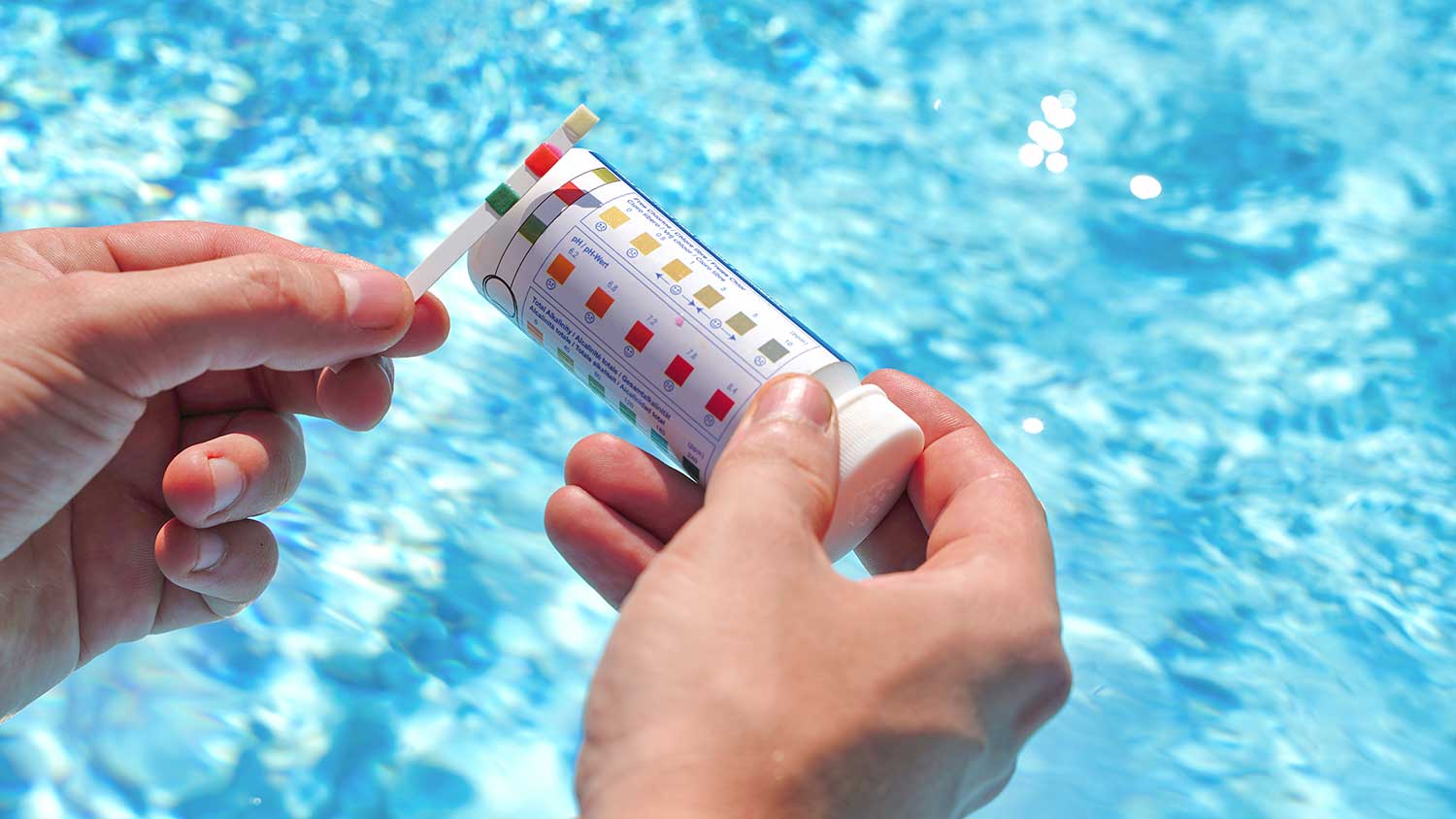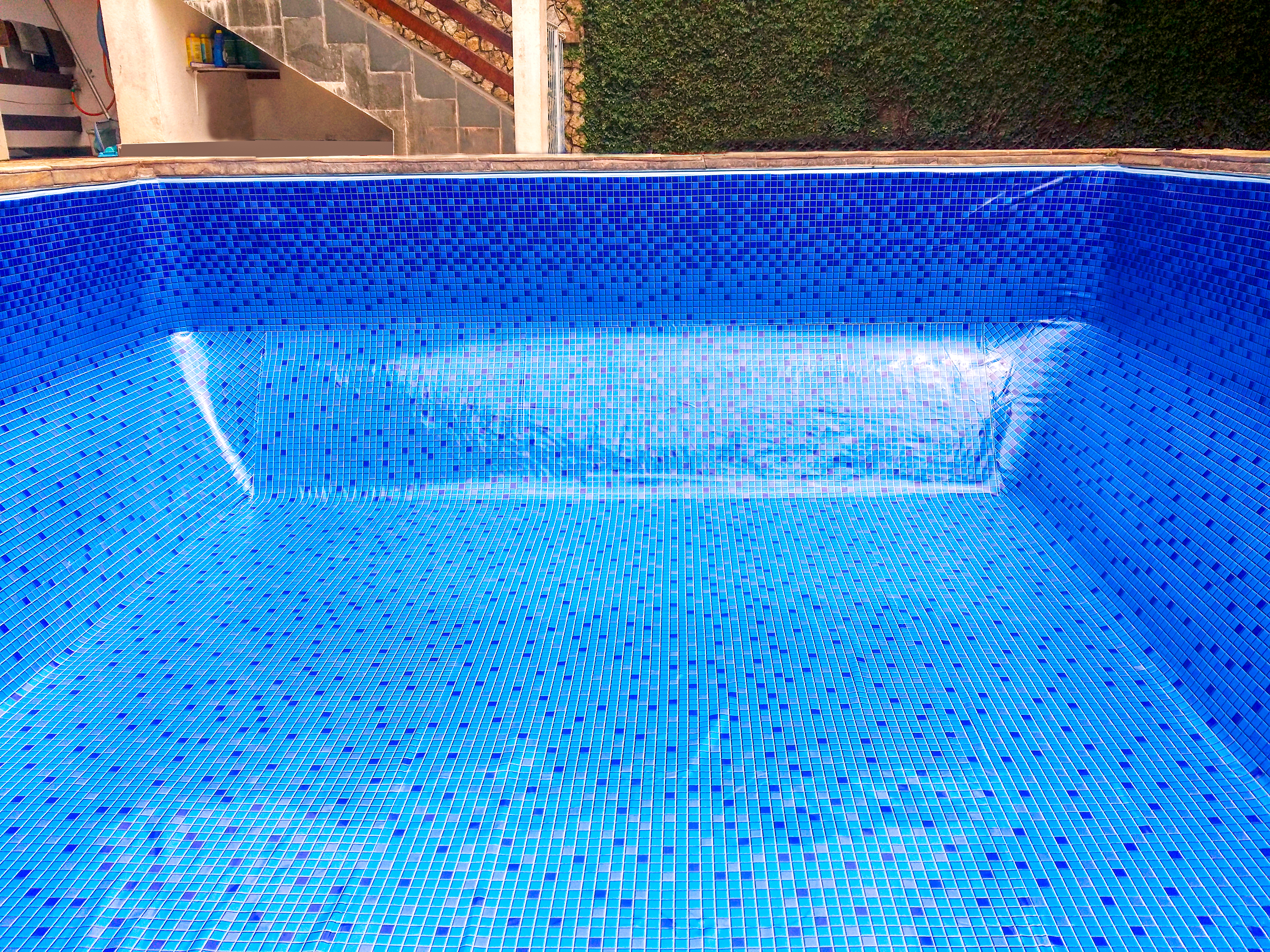
If you’ve been considering installing a new pool in the Buckeye State, this guide will help you understand inground pool costs in Columbus.
Dive into fixes for this common pool problem


Algae growth is the most common culprit of green pool water and can occur from several stimuli, like poor circulation and low chlorine levels.
It’s important that a pool’s chlorine levels are neither too low nor too high because too much chlorine can cause metal to oxidize and turn your pool green.
If your pool contains too much cyanuric acid, you’ll need to replace half the water in your pool to rebalance the water.
Your neighbors may be green with envy of your pool, but you don’t want your water to match—green pool water is a sign something is amiss. Our guide will help you pinpoint why your pool water is green and take you through the steps to fix it so you can get back to perfecting your backstroke.
Your pool water can turn green for several reasons, some of which can make your pool unsafe for swimming. If your pool has algae overgrowth, too little chlorine, mold growth, or a broken filter, the water quality can fall below safe levels.
If you don’t know why your pool is green, stay out of the water until it’s cleared up.
Before finding the best way to remedy the issue, you have to figure out exactly what’s causing it in the first place. To do so, you’ll need to gather a few tools to examine the water, like pH test kits, and check that all parts of your pool are functioning as they should. Ensure that nothing from your surrounding environment, such as excessive pollen, could be the source of the problem.
Once you’ve determined the source of the color change, all it takes is a matter of time to turn it back to blue. Keep reading to find out what common pool problems can cause your pool to turn green.
Algae overgrowth is the most common cause of green pool water. Anything from a chemical imbalance to improper water circulation or filtration can trigger it. You’ll know algae is your issue if you spot sheets or small pieces of slimy growth floating around or gathered on your pool's surface, floor, or sides. You're most likely to encounter four types of algae blooms, and each one comes with different risks.
For starters, green- and mustard-colored algae are the two types most likely to infect your pool. While not toxic, both harbor harmful bacteria that can pose certain health risks, like skin rashes and even allergic reactions like coughing. Green algae grow due to a lack of water circulation, filtration, or low chlorine levels. In contrast, yellow algae are more likely to stem from a large accumulation of debris like pollen or high phosphate levels. Green algae grow much more quickly than yellow algae, but the former is easier to remove than the latter.
Red algae is another type that you may run into. This algae is a bacteria that forms on human skin and anything we come into contact with (like pool toys and accessories). Cleaning your pool and pool accessories regularly and rinsing off before diving in will help prevent red algae from forming.
Last but most certainly not least, take extra precautions when dealing with black algae because this could be a sign that you’re dealing with a black mold infestation. Black mold causes numerous safety hazards, like encouraging the growth of dangerous bacteria, so it’s best to hire a pool maintenance pro to take care of it in these cases.

Pollen is another common green pool culprit for a handful of reasons. For one, when large amounts of pollen suddenly accumulate in your pool (during spring, for example), it transfers its yellow-green tint directly to the water, causing an almost instantaneous transformation. Large amounts of pollen can also block your water filtration and circulation systems and encourage algae growth. Prevent problems with pollen by covering your pool when pollen counts are high and removing any debris from the water the moment you spot it.
While low pool chlorine levels don’t directly contribute to green pool water, they can make it easier for green algae and the like to start growing. Algae growth is less likely to form if chlorine levels are stable.
Fortunately, it’s easy to ensure that this is never your problem. Shock your pool with chlorine every week to keep everything in check. On the flip side, you also want to make sure that you’re not using too much chlorine because excessive amounts of this substance can cause the metal components of your pool to oxidize and turn the water green in its own right.
If the pH level of your pool is too high—above 7.8 when tested—this will inhibit the chlorine from functioning and make your water more susceptible to things that could turn it green, like algae or pollen. Test your pool's pH levels often to ensure everything is in check. Add the appropriate chemicals, like sodium bisulfate or muriatic acid, if it rises above the recommended amount to lower your pool’s pH.
Your pool is at risk of algae development any time there’s an imbalance of chemicals in your pool water, including when there’s a high concentration of phosphates. Ideally, your pool should contain none whatsoever, but phosphates often find their way into the water via landscaping and fertilizing materials that contain the chemical.
On top of that, phosphates encourage algae growth, making it stronger and more difficult to remove the longer the problem goes unresolved. Prevent phosphates from forming in your pool water by removing debris immediately after stormy weather or whenever you notice it. Brush the sides and floor of your pool regularly, keep it covered during storms, and check on your filtration system every so often to ensure it’s functioning as it should.

Cyanuric acid is used in pools to prevent the sun’s UV rays from breaking down chlorine. Using too little cyanuric acid won’t sufficiently protect the chlorine, and too much will actually have the reverse effect and stop the chlorine from working. If the cyanuric acid levels are above or below 30 to 50 ppm when tested, you’ll need to take action.
Adding more is easy, but removing cyanuric acid isn’t as simple as adding a chemical remover to your pool. Diluting your pool is the only way to reduce cyanuric acid levels. To do so, you’ll need to empty half of your pool and refill it with fresh, non-chlorinated water to have the desired effect.
If the pool filter isn’t functioning properly, chemical imbalances are more likely to happen, and algae growth is more likely to develop in your pool as a result. You’ll know that your filter is the problem behind your algae infestation if the water in your pool is noticeably cloudy or there seems to be excessive debris, even if you regularly clean your pool. In most cases, it’s more affordable to replace a broken pool filter than to try repairing it. The cost to replace a pool filter is $1,500 to $2,000 on average.
Taking care of your pool on a regular basis will keep algae at bay. Add these tasks to your pool maintenance checklist to ensure your swimming spot never turns green.
Testing your pool water is the best way to ensure there are no chemical imbalances that can suddenly cause it to turn green. Try to test your pool's pH and alkaline levels every two weeks and the phosphate levels just before and after the swimming season.
Your pool’s pH levels should be between 7.4 and 7.8. If it’s more or less than that, use a few tricks to raise or lower the pH levels of your pool, like adding sodium bisulfate or sodium carbonate.
Your pool’s alkaline levels should be between 80 and 120 ppm (parts per million). If the levels are below 80, add 25 pounds of sodium bicarbonate (or baking soda) to every 10,000 gallons of water. If it’s more than 120, use the same amount of sodium bisulphate to balance the water. If you aren’t sure how many gallons your pool holds, a pool volume calculator can help you figure it out.
As for phosphates, a pool can safely contain 100 to 125 ppm without issues, but you’ll need to treat any amounts higher than that with phosphate remover before attempting to remove algae—otherwise, it can grow back.
Once you’ve determined which algae you’re dealing with, you can use the same basic method to clean each one up (except for black algae, which you should leave to a pro). Before starting the removal process, wear gloves, full-length clothing, goggles, and a face mask to protect yourself from harmful bacteria and VOCs.
To get rid of algae growth in your pool, treat your pool water with a gallon of chlorine shock for every 10,000 gallons of water. Then, find a pool-cleaning chemical for the type of algae you’re dealing with. You’ll need about 6 ounces of algaecide for every 10,000 gallons of water. Next, brush the pool walls and floor, turn on your filtration system, and vacuum your pool to get any algae that isn’t filtered out. Let your pool rest for 48 hours before using it.
Regularly removing debris from your pool is the key to ensuring that chemical levels remain balanced and that no pesky pollen suddenly turns your pool water green. Even a little bit of dirt, dust, or bugs can throw off pH and alkaline levels and even cause excessive phosphates to form, so try to do this task daily while your pool is in active use.
While it might not seem that important, cleaning your pool accessories after removing algae from a pool is an absolute must. If not, all the chemicals that caused the algae to form will still be on these items, making it more likely that your pool will quickly redevelop algae once you throw them back in. For best results, clean them separately with a chlorine-based cleaner, rinse them, and set them aside for later.
No time to maintain your pool? Most pool contractors offer seasonal maintenance. Talk to your pro about scheduling check-ups to keep your pool healthy.
If you have a black algae infestation in your pool, you’ll need to replace your filter or use specific chemicals to solve a problem (like high phosphate levels). You’re better off letting someone with years of experience restore your pool back to blue. These instances can be especially risky if you aren’t familiar with using chemical cleaners or the inner workings of pool repairs. When in doubt, find a pool technician in your area to help you take care of any heavy-duty issues.
Audrey Bruno contributed to this piece.
From average costs to expert advice, get all the answers you need to get your job done.

If you’ve been considering installing a new pool in the Buckeye State, this guide will help you understand inground pool costs in Columbus.

The cost of pool liner replacement in Columbus depends on the size and shape of your pool, as well as the liner material and type. Here’s how the costs break down.

Are you thinking about filling your pool? The cost to fill a pool depends on the type of fill used and the size of your pool.

Getting your pool ready for the season or shutting it down afterward requires a talk with a pro about these pool opening and closing questions.

Swimming pools come in many sizes, but this pool size chart will simplify your choices and give you tips on how to choose the perfect size for your space.

Keeping your pool heated can make it comfortable even in chilly weather. Learn what size pool heater you need to keep your pool as warm as you like.